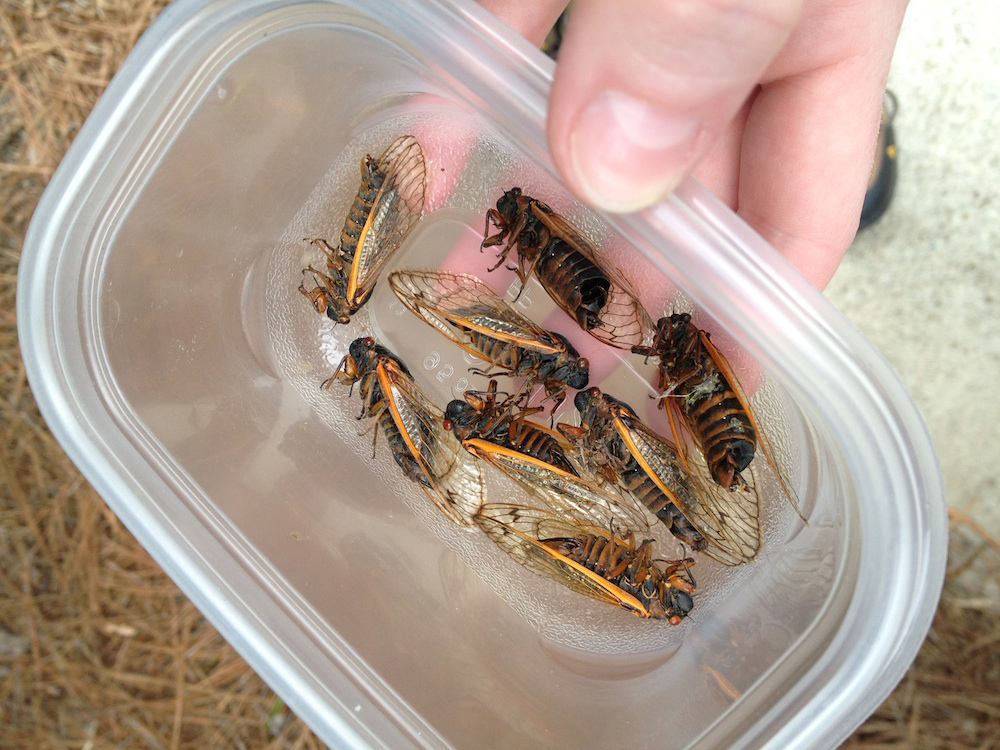Science Note- Cicadas Meet Citizen Science
Air Date: Week of June 28, 2013

A live seventeen-year cicada (Photo: Holly Menninger)
Seventeen-year cicadas are coming to the end of their season, and a team at North Carolina State University wants citizens to send them cicada corpses. Measuring the dead insects can help show how urbanization is impacting the species. Erin Weeks reports on the citizen science project.
Transcript
CURWOOD: It's Living On Earth, I'm Steve Curwood. Just ahead, a race to discover some of the tiniest animals. But first, this note on emerging science from Erin Weeks.
WEEKS: They’ve got blood red eyes, translucent, orange-veined wings, and they’re in frenzied pursuit of mates. Seventeen-year cicadas are buzzing up and down the east coast, and as their season comes to a close, they leave behind billions of large, smelly corpses.
A team of scientists at North Carolina State University is taking advantage of their deaths to test a theory - and they want help. They’ve asked folks in cicada hotspots to collect the dead insects and mail them to their lab in Raleigh.

A collection of dead cicadas (Photo: Holly Menninger)
You see, there’s a lot you can learn about cicadas by measuring the asymmetry, or crookedness, of their bodies. In 1996, still in nymph form, this year’s brood of cicadas burrowed underground beneath trees to begin the long transformation into adulthood.
In the seventeen years since then, some forests have been replaced by roads and buildings, trapping many nymphs in the earth. Others faced stresses such as pollution and extreme temperatures. These conditions can interrupt normal insect development - and cause bugs to grow a little bit off-kilter.
To gauge just how much urbanization impacts cicadas, the NCSU team wants to measure these lopsided quirks in wing, vein, and leg sizes and compare specimens from rural, suburban, and urban locations.
So, if you live in the cicada zone, you too can contribute a few bodies in the name of citizen science. Happy hunting!
That’s this week’s note on emerging science. I’m Erin Weeks.
CURWOOD: There's more about the cicada project at our website, LOE.org.
Links
To learn more about how you can participate, visit http://www.yourwildlife.org/projects/urban-buzz/.
Living on Earth wants to hear from you!
Living on Earth
62 Calef Highway, Suite 212
Lee, NH 03861
Telephone: 617-287-4121
E-mail: comments@loe.org
Newsletter [Click here]
Donate to Living on Earth!
Living on Earth is an independent media program and relies entirely on contributions from listeners and institutions supporting public service. Please donate now to preserve an independent environmental voice.
NewsletterLiving on Earth offers a weekly delivery of the show's rundown to your mailbox. Sign up for our newsletter today!
 Sailors For The Sea: Be the change you want to sea.
Sailors For The Sea: Be the change you want to sea.
 The Grantham Foundation for the Protection of the Environment: Committed to protecting and improving the health of the global environment.
The Grantham Foundation for the Protection of the Environment: Committed to protecting and improving the health of the global environment.
 Contribute to Living on Earth and receive, as our gift to you, an archival print of one of Mark Seth Lender's extraordinary wildlife photographs. Follow the link to see Mark's current collection of photographs.
Contribute to Living on Earth and receive, as our gift to you, an archival print of one of Mark Seth Lender's extraordinary wildlife photographs. Follow the link to see Mark's current collection of photographs.
 Buy a signed copy of Mark Seth Lender's book Smeagull the Seagull & support Living on Earth
Buy a signed copy of Mark Seth Lender's book Smeagull the Seagull & support Living on Earth

